Crop Protection :: Pests of Banana
BORERS
Rhizome weevil, Cosmopolites sordidus
| Symptoms of damage |
- Grubs bore into the rhizome and cause death of the plant
- Presence of dark coloured tunnels in the rhizomes.
- Death of unopened pipe, withering of outer leaves.
|
|
|
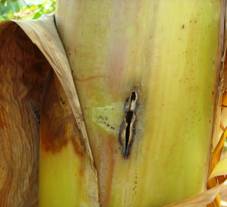 |
|
|
Grub bore hole |
Corm damage |
Stem Damage |
| Identification of pest |
- Eggs - laid singly, white in colour
- present on the upper part of rhizome
- Grub - Apodous, yellowish white with red head
- Pupa - white in colour, occur in inside the corm and tunneling
- Adult - Dark weevil, newly emerged weevil is red brown
|
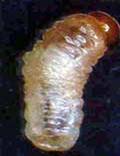 |
 |
| Pupa |
Adult |
|
| Management |
- Select healthy sucker and plant
- Do not take regular crop in the same field to avoid initial infestation
- Ensure clean cultivation
- Removal of pseudo stems below ground level
- Trimming the rhizome
- Avoid growing Robusta, Karpooruvally, Malbhog, Champa and Adukkar
- Grow less susceptible varieties like Poovan, Kadali, Kunnan, Poomkalli
- Use cosmolure trap at 5/ha
|
Banana corm split trap
| Symptoms of damage |
- Trap adult weevils with pseudostem chopped into small pieces
- kept near infested clump at 65/ha.
- Soil incorporation at the time of planting: carbofuran 3 G 10g, phorate 10 G 5 g/plant, lindane 1.3 D 20 g/plant.
- Before planting, the suckers should be dipped in 0.1 per cent quinalphos emulsion.
- Apply castor cake 250g or carbaryl 50g dust or phorate 10g per pit before planting also prevents infestation
- Severe attack dimethoate, methyl demeton, or phosphamidon may be sprayed around the collar region.
|
Pseudostem borer, Odoiporus longicollis
| Symptoms of damage |
- Grub bore into pseudostem making tunnels
- Cutting holes on outer surface
- Exudation of plant sap – initial symptom
- Blackened mass comes out from the bore hole
- Tunneled part decomposes and pseudostem becomes weak
- Wilting of the plant.
|
 |
| Bore holes on pseudostem |
|
| Identification of pest |
- Eggs – are laid at random on cut ends of pseudostem, yellowish-white, cylindrical in shape
- Grub - Apodous, creamy white with dark brown head.
- Pupa – pale yellow colour, fibrous cocoon formed inside the tunneling on the periphery
- Adult - Robust, reddish brown and black weevil.
|
 |
| Adult |
|
| Management |
- Remove dried leaves periodically and keep the field clean
- Prune the side suckers every month
- Use healthy and pest free suckers to check the pest incidence
- Do not dump infested materials into manure pit
- Uproot infested trees, chop into pieces and burn
- Use longitudinally split pseudostem trap at 65/ha
Note
- 2ml at 45 cm from ground level; another 2m at 150 cm from ground level
|
SAP FEEDERS
Banana aphid, Pentalonia nigronervosa f. typica
| Symptoms of damage |
- Leaves are bunched into a rosette appearance
- Leaf margins are wavy and upward rolling
- Stunted growth of the plant
- Do not produce bunches
- Vector of bunchy top disease.
- Seen in colonies on leaf axils and pseudostem
|
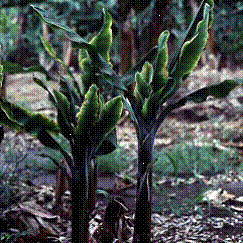 |
| Banana bunchy top |
|
| Identification of pest |
- Nymphs - are dark in colour
- Adult – Brownish and has black veined wings
|
 |
 |
| Aphids on under surface of leaves |
Winged adult |
|
| Management |
- Ensure clean cultivation
- Use healthy and pest free suckers to check the pest incidence
- Destroy diseased plants with rhizome
- Direct the spray towards the crown and pseudostem base upto ground level
- Encourage activity of predators:
- Scymnus, Chilomenes sexmaculatus, Chrysoperla carnea and other coccinellids;
- Use entomopathogens, Beauveria bassiana
|
Tingid or Lace wing bug, Stephanitis typicus
| Symptoms of damage |
- Grubs bore into the rhizome and cause death of the plant
- Presence of dark coloured tunnels in the rhizomes.
- Death of unopened pipe, withering of outer leaves.
|
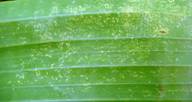 |
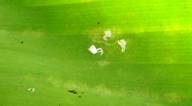 |
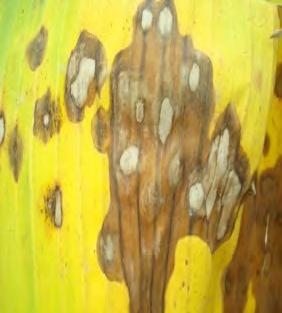 |
| Yellowish spots on leaves |
Adult |
Leaf Spot |
|
| Identification of pest |
- Nymphs – are yellow colour, occur in under surface
- Adult – yellow colour with minute fringed wings, seen in under surface of leaves
|
| Management |
- Collect and destroy the damaged leaves, flowers and fruits along with life stages
- Spraying with dimethoate 30 EC - 850 ml/ha or phosphamidon 85 WSC - 300 ml/ha
- Use yellow sticky trap at 15/ha
- Spray carbendazim 3g/ litre of water Application of press mud at 5 kg per tree reduces the wilt incidence
|
Hard scale, Aspidiotus destructor
| Symptoms of damage |
- Grubs bore into the rhizome and cause death of the plant
- Presence of dark coloured tunnels in the rhizomes.
- Death of unopened pipe, withering of outer leaves.
|
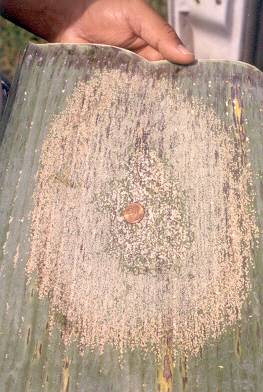 |
 |
| Banana scale |
| Identification of pest |
- Nymph - Oval translucent, Yellowish brown with waxy coating.
- Adult - Female circular, semi transparent and pale brown.
|
 |
| Adult and crawlers |
|
| Management |
- Collect and destroy the affected plant parts
- Field release of coccinelid predators like Chilocorus nigritus, Symnus coccivora
|
Fruit rust thrips, Chaetanaphothrips signipennis
| Symptoms of damage |
- Rusty reddish discolouration on the fingers
- Yellowing of leaves and rusty growth over fruit.
|
| Identification of pest |
- Adult - Yellowish white with shaded wings.
|
| Management |
- Destroy all volunteer plants and old neglected plantations
- Use healthy and pest free suckers for planting
- Hot water treatment prior to planting.
- Bunch covers (which cover the full length of the bunch) protection applied very early.
- Regular checking of fruit under the bunch covers is essential to ensure that damage
- Bunches, pseudostem and the suckers should be sprayed chlorpyrifos
- Soil application fipronil and bifenthrin
- Field release of coccinelid predators like lacewings, ladybird beetles
|
LEAF FEEDERS
Castor hairy caterpillar, Pericallia ricini
| Symptoms of damage |
- Caterpillar scraping the chlorophyll content and windowing in unfurled leaves.
|
| Identification of pest |
- Larva - Black with brown head having long brown hairs
- Adult - Grey coloured with dark spots on the pinkish hind wings.
|
 |
| Pericallia ricini |
|
| Management |
- Collect and destroy egg masses and caterpillars
- Use burning torch to kill the congregating larvae
- Use light trap to attract and kill the adults
- Spray chlorpyriphos 20 EC or quinalphos 25 EC 2ml/lit
|
Cut worm, Spodoptera litura
| Symptoms of damage |
- Young larvae feed by scrapping the leaves from ventral surface
- Later on feed voraciously at night on the foliage.
|
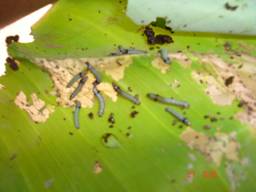 |
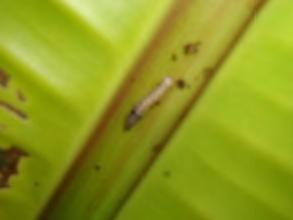 |
| Scrabbing of larvae |
|
| Identification of pest |
- Larva - Pale greenish brown with dark marking.
- Yellow and purplish spots in the sub marginal areas.
- Fore wing - Stout moth with wavy white markings on the brown.
- Hind wings - white having a brown patch along the margin.
|
| Management |
- Hank pick and destroy the caterpillar
- Collect and destroy the damaged plant parts
- Summer ploughing to expose to the pupae
- Use light trap 1/ha
- Spray application of azinphosethyl, chlorphyriphos
- Severe infestation – spot application of Bt
- Foliar spray with avanthe 1 ml in 100 ml of water
- Field release of egg parasitoid
- Field release of entomopathogenic fungus, Nomuraea rileyi
|
 |
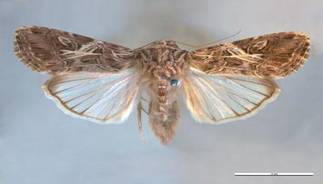 |
| Larva |
Adult |
|
|
|

